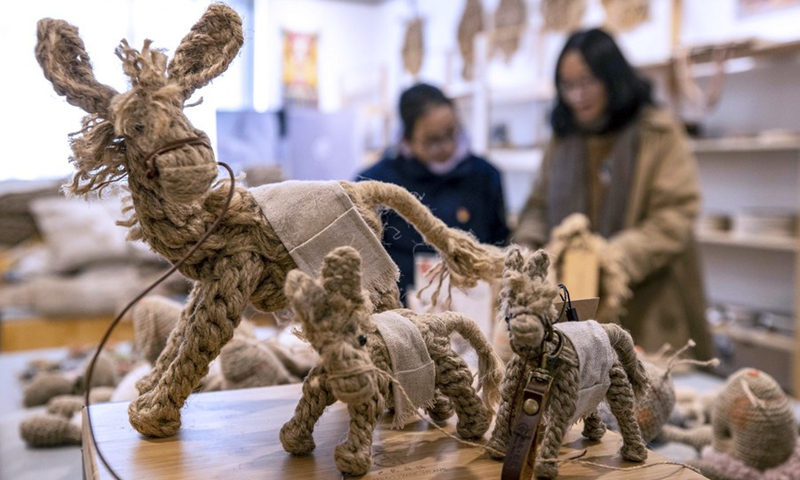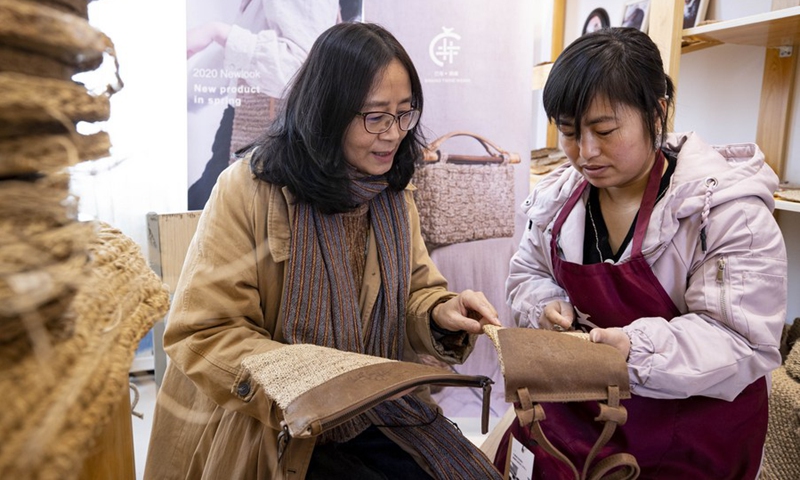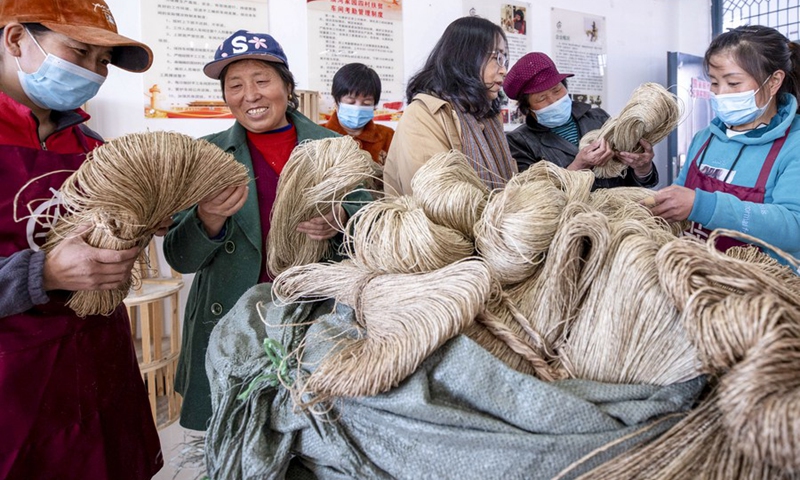
Photo taken on March 4, 2022 shows the hemp weaving products displayed at the hemp weaving workshop in Yueyahu Township, Yinchuan, capital of northwest China's Ningxia Hui Autonomous Region.(Photo: Xinhua)

Zhang Jing (L) teaches the skills of hemp weaving to a villager in Yueyahu Township, Yinchuan, capital of northwest China's Ningxia Hui Autonomous Region, March 4, 2022.(Photo: Xinhua)

Villagers select the raw material of hemp weaving in Yueyahu Township, Yinchuan, capital of northwest China's Ningxia Hui Autonomous Region, March 4, 2022. (Photo: Xinhua)
In a handicraft workshop in northwest China's Ningxia Hui Autonomous Region, lambs, little camels, and many other toy animals plaited with hemp twines were on display and waiting for a sale.
These hemp handicrafts sell to consumers from big cities and foreign countries.
"I am proud of my products and happy to see they are sold abroad," said Wang Xiulan, 58, one of the makers of these hemp-plaiting toy animals. Wang, who used to live in Xihaigu, a region long deemed "uninhabitable," relocated to a village in Yueyahu Township in Yinchuan, the capital of Ningxia.
Unlike most young men who could easily find a job outside, it is difficult for the old, the disabled, and the left-behind women like Wang to have stable incomes since they lack the necessary skills to make money.
Things did not change until the arrival of Zhang Jing, an inheritor of the traditional artistry of hemp twines plaiting. To help these people find jobs, the local government built up the Yueyahu handicraft workshop in 2017.
The Yinchuan art gallery sent Zhang to teach villagers at the workshop. "Since then, I began my new art creation by teaching villagers skills and helping them earn more money with hemp twines," said Zhang.
China is one of the earliest countries to plant and use hemp. With a good tenacity and moisture absorption ability, hemp was used to make ropes, shoes, and hats in China since ancient times. History records show that hemp plantations were common in the Han Dynasty (202 B.C.-220 A.D.). In recent years, the traditional artistry of hemp-twine plaiting was listed as a regional intangible cultural heritage.
As the fourth generation to inherit this skill, Zhang still remembers that many bits of hemp were grown on both sides of the Yellow River when she was young. Over the past years, the popular aesthetic concept of original ecology put handicrafts plaited with hemp twines into the spotlight again.
In the beginning, many villagers doubted the hemp-twine plaiting work, and few would join. "I thought hemp fiber products should be cheap," recalled Wang, adding that she did not even know how to hold a needle.
Zhang teaches villagers hand by hand and provides hemp twines for free to encourage more people to engage. Zhang purchases these products and pays villagers on a piecework basis. "Some products were not qualified for sale, but I still paid. Only in this way could villagers keep up with us," said Zhang.
There are about 70 regular workers in the workshop, and some could earn about 10,000 yuan (1,491 U.S. dollars) a year at most. "These elderly, disabled, and left-behind women belong to a marginalized group who need to be mobilized," said Zhang.
Ma Youyun, 54, is one of the disabled trainees with excellent performance in hemp-twine plaiting. Losing his right leg in a car accident had depressed him for a long time, but now he rebuilds confidence in life thanks to hemp-twine plaiting training.
"I'm able to earn some pocket money now, and it makes me feel that I'm still useful," said Ma, who wore a brown round cap he plaited the other day.
To better inherit the traditional artistry and help villagers earn more money, Zhang has creatively designed a series of products, including some fashion-oriented utilities like wallets, coasters, and reticules.
"What I'm doing is called 'productive inheritance.' In other words, villagers could benefit from plaiting products with hemp twines, during which the traditional artistry of hemp-twines plaiting will pass on with new vitalities," said Zhang.
According to Zhang, these handicrafts traveled far to China's Beijing, Shanghai, and even some cities in the United States. Zhang would always tie a tag to each handicraft for sale with photos of the villager's smiling faces and autographs to build a special connection between consumers and villagers.
"I believe the design would make consumers feel warm because there are many stories behind those tags," said Zhang.
